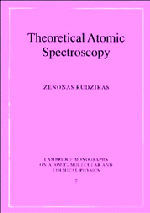Book contents
- Frontmatter
- Contents
- Preface
- Foreword to the Paperback Edition
- Introduction
- Part 1 Energy Spectrum of Many-electron Atom. Radiative and Autoionizing Transitions (Initial Formulas)
- Part 2 Foundations of the Angular Momentum Theory. Graphical Methods
- Part 3 Description of Complex Electronic Configurations
- Part 4 Second-quantization in the Theory of an Atom. Quasispin and Isospin
- Part 5 Matrix Elements of the Energy Operator
- Part 6 Electric and Magnetic Multipole Transitions
- Part 7 Calculation of Energy Spectra and Electronic Transitions in the Case of Complex Configurations
- 28 Methods of determination of radial orbitals
- 29 Correlation effects. Perturbation theory
- 30 The role of gauge dependence, relativistic and correlation effects in electronic transitions
- 31 Peculiarities of the structure and spectra of highly ionized atoms
- 32 Global methods in the theory of many-electron atoms
- 33 Peculiarities of configurations with vacancies in inner shells
- Epilogue
- References
- Index
30 - The role of gauge dependence, relativistic and correlation effects in electronic transitions
Published online by Cambridge University Press: 21 September 2009
- Frontmatter
- Contents
- Preface
- Foreword to the Paperback Edition
- Introduction
- Part 1 Energy Spectrum of Many-electron Atom. Radiative and Autoionizing Transitions (Initial Formulas)
- Part 2 Foundations of the Angular Momentum Theory. Graphical Methods
- Part 3 Description of Complex Electronic Configurations
- Part 4 Second-quantization in the Theory of an Atom. Quasispin and Isospin
- Part 5 Matrix Elements of the Energy Operator
- Part 6 Electric and Magnetic Multipole Transitions
- Part 7 Calculation of Energy Spectra and Electronic Transitions in the Case of Complex Configurations
- 28 Methods of determination of radial orbitals
- 29 Correlation effects. Perturbation theory
- 30 The role of gauge dependence, relativistic and correlation effects in electronic transitions
- 31 Peculiarities of the structure and spectra of highly ionized atoms
- 32 Global methods in the theory of many-electron atoms
- 33 Peculiarities of configurations with vacancies in inner shells
- Epilogue
- References
- Index
Summary
Electronic transitions in intermediate coupling
As we have seen in Chapter 11, the energy levels of atoms and ions, depending on the relative role of various intra-atomic interactions, are classified with the quantum numbers of different coupling schemes (11.2)–(11.5) or their combinations. Therefore, when calculating electron transition quantities, the accuracy of the coupling scheme must be accounted for. The latter in some cases may be different for initial and final configurations. Then the selection rules for electronic transitions are also different. That is why in Part 6 we presented expressions for matrix elements of electric multipole (Ek) transitions for various coupling schemes.
In various pure coupling schemes the intensities of spectral lines may differ significantly. Some lines, permitted in one coupling scheme, are forbidden in others. Comparison of such theoretical results with the relevant experimental data may serve as an additional criterion of the validity of the coupling scheme used.
Studies of spectra of many-electron atoms and ions show that the presence of a pure coupling scheme is the exception rather than the rule. Therefore, their energy spectra must be calculated, as a rule, in intermediate coupling via diagonalization of the total energy matrix, starting with the coupling scheme assumed to be closest to reality. In such a case the electronic transitions must also be calculated in intermediate coupling.
The wave function in intermediate coupling is a linear combination of the relevant quantities of pure coupling (see (11.10)).
- Type
- Chapter
- Information
- Theoretical Atomic Spectroscopy , pp. 357 - 367Publisher: Cambridge University PressPrint publication year: 1997



